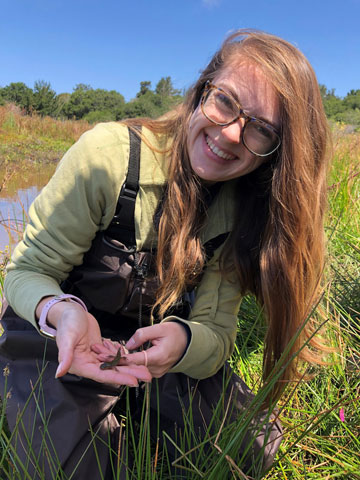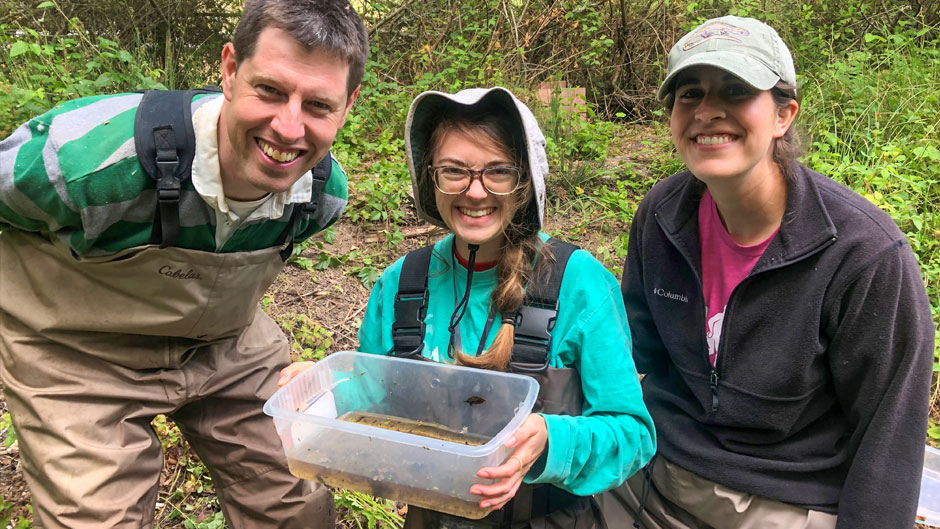Leyna Stemle, a biology Ph.D. student working with postdoctoral researcher, Arianne Messerman, and assistant professor Christopher Searcy, is visiting the central California coast this summer to study an endangered amphibian species called the Santa Cruz long-toed salamander. These four-to-six-inch salamanders are estimated occur in only 23 breeding ponds, a figure that has likely declined since the species was initially described in 1954. The enigmatic species has long puzzled researchers, as it inhabits a small enclave of coastal habitat over 100 miles from its nearest relatives, which are all found in snow-fed ponds high in the Sierra Nevada and Cascades Mountains.

Stemle addressed some questions and shared some thoughts about the experience.
Where are you conducting your field research?
In Monterey and Santa Cruz counties, which are in central California along its western coast. Dr. Messerman and I are living in Monterey County near the Santa Cruz border for the summer, but we are not camping on-site because it is mostly government-owned protected land. We sampled 27 ponds across the salamanders’ entire range in early June, but we are now focusing on nine of the ponds.
What species were you studying? Why?
We are studying the Santa Cruz long-toed salamander. This is an endangered salamander, and has been since 1967, when it was a member of the inaugural class of endangered species listed in the United States. They only breed in about 23 ponds worldwide, so we are studying them to understand their habitat requirements in order to know how to conserve them. Due to sea level rise, almost all of the ponds they breed in within Monterey County will likely be inundated with salt water from the Pacific Ocean by around 2060. This will cause the ponds to be uninhabitable. Therefore, we must understand their pond requirements to be able to create artificial ponds that will sustain the species.
What is their typical habitat?
Younger long-toed salamanders typically live in seasonal ponds formed from rainwater or groundwater, in Monterey and Santa Cruz Counties in central California. Once the young emerge from ponds, we do not know much about their preferred habitat. But from previous work by environmental consultants, we think they prefer slightly forested areas and spend the majority of their adult life underground in small mammal burrows.
Why are they such an important species?
This species can be thought of as a canary in a coal mine. If the habitat they live in is unhealthy, they are likely one of the first species to disappear or decline, which can be a sign to humans that something is wrong. They are no longer found in about 25 percent of the ponds where they were discovered in past research. These losses are likely due to issues related to climate change (drought, sea level rise) and urbanization (loss of habitat). We hope to be able to help better quantify the decline through our long-term work on the salamanders.
What types of specimens/data were you collecting?
At each pond, we gather water chemistry data (pH, salinity, nitrates, depth, etc.), as well as information on what food is available for the salamanders in the pond and what predators there are in the region that may be eating them. Of course, we also count the young salamanders that are in the pond. We caught around 600 young salamanders during pond sampling and measured and weighed them before release (this can be a good indicator of how healthy they are). Later on, I will use computer software to see if urbanization and agriculture surrounding the ponds impact how many young salamanders there are in each pond. This land-use data is important since adult and juvenile salamanders live in the areas adjacent to the ponds.
How is this useful?
We hope to find patterns that we can use to help guide environmental management decisions on what a healthy salamander pond should look like. This information can then be used to determine the best ponds in which to release captive-bred individuals (raised in tanks at the University of California, Santa Cruz), as well as to guide future pond creation (the actual construction of artificial ponds) to help support the species.
What is the goal of the research?
We hope that by studying the Santa Cruz long-toed salamander, we can better understand their ecology and how they have evolved to persist in their unique habitat. We also want to provide data that could be used by government wildlife agencies to help prevent the extinction of the species.
Can this knowledge be applied to understand other ecosystems?
Understanding the degree of synchrony—or how much populations fluctuate together and independently—across the salamanders’ range is an important part of modeling their population dynamics. This will likely allow us to predict their probability of persisting into the future. And by monitoring populations across the entire range of this species, we hope that our estimates will help inform population models not only of this species, but of other imperiled amphibian species as well.

